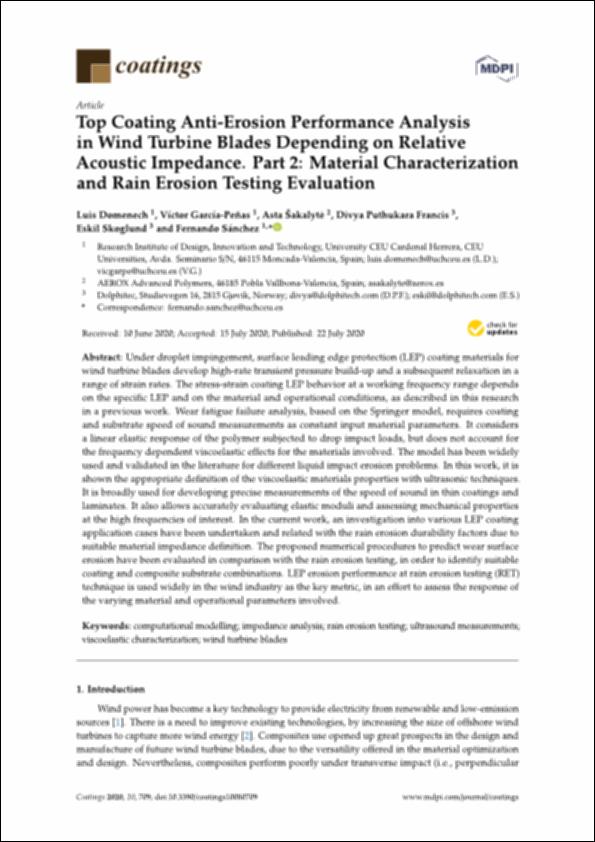Por favor, use este identificador para citar o enlazar este ítem:
http://hdl.handle.net/10637/12605Top coating anti-erosion performance analysis in wind turbine blades depending on relative acoustic impedance. Part 2, Material characterization and rain erosion testing evaluation
| Título : | Top coating anti-erosion performance analysis in wind turbine blades depending on relative acoustic impedance. Part 2, Material characterization and rain erosion testing evaluation |
| Otros títulos: | Material characterization and rain erosion testing evaluation |
| Autor : | Doménech Ballester, Luis García Peñas, Víctor Sakalyté, Asta Francis, Divya Puthukara Skoglund, Eskil Sánchez López, Fernando |
| Materias: | Materiales de revestimiento.; Coatings.; Rain erosion.; Wind power.; Erosión pluvial.; Energía eólica. |
| Editorial : | MDPI |
| Citación : | Domenech, L., García-Peñas, V., Šakalytė, A., Puthukara Francis, D., Skoglund, E. & Sánchez, F. (2020). Top coating anti-erosion performance analysis in wind turbine blades depending on relative acoustic impedance. Part 2, Material characterization and rain erosion testing evaluation. Coatings, vol. 10, i. 8 (22 jul.), art. 709. DOI: https://doi.org/10.3390/coatings10080709 |
| Resumen : | Under droplet impingement, surface leading edge protection (LEP) coating materials for wind turbine blades develop high-rate transient pressure build-up and a subsequent relaxation in a range of strain rates. The stress-strain coating LEP behavior at a working frequency range depends on the specific LEP and on the material and operational conditions, as described in this research in a previous work. Wear fatigue failure analysis, based on the Springer model, requires coating and substrate speed of sound measurements as constant input material parameters. It considers a linear elastic response of the polymer subjected to drop impact loads, but does not account for the frequency dependent viscoelastic e ects for the materials involved. The model has been widely used and validated in the literature for di erent liquid impact erosion problems. In this work, it is shown the appropriate definition of the viscoelastic materials properties with ultrasonic techniques. It is broadly used for developing precise measurements of the speed of sound in thin coatings and laminates. It also allows accurately evaluating elastic moduli and assessing mechanical properties at the high frequencies of interest. In the current work, an investigation into various LEP coating application cases have been undertaken and related with the rain erosion durability factors due to suitable material impedance definition. The proposed numerical procedures to predict wear surface erosion have been evaluated in comparison with the rain erosion testing, in order to identify suitable coating and composite substrate combinations. LEP erosion performance at rain erosion testing (RET) technique is used widely in the wind industry as the key metric, in an e ort to assess the response of the varying material and operational parameters involved. |
| Descripción : | Este artículo se encuentra disponible en la siguiente URL: https://www.mdpi.com/2079-6412/10/8/709 Este artículo pertenece al número especial "Recent trends in coatings and thin film?modeling and application". |
| URI : | http://hdl.handle.net/10637/12605 |
| Derechos: | http://creativecommons.org/licenses/by/4.0/deed.es |
| ISSN : | 2079-6412 (Electrónico). |
| Fecha de publicación : | 22-jul-2020 |
| Centro : | Universidad Cardenal Herrera-CEU |
| Aparece en las colecciones: | Dpto. Matemáticas, Física y Ciencias Tecnológicas |
Los ítems de DSpace están protegidos por copyright, con todos los derechos reservados, a menos que se indique lo contrario.


